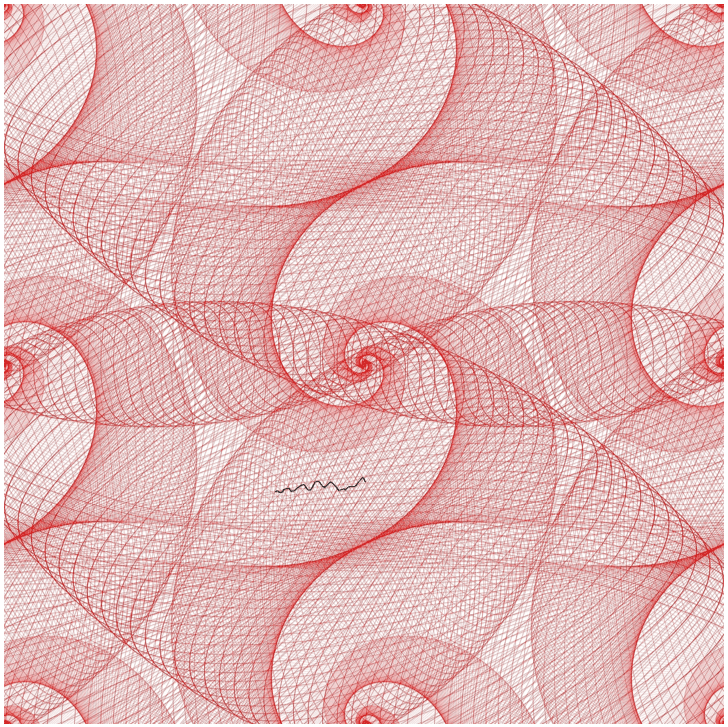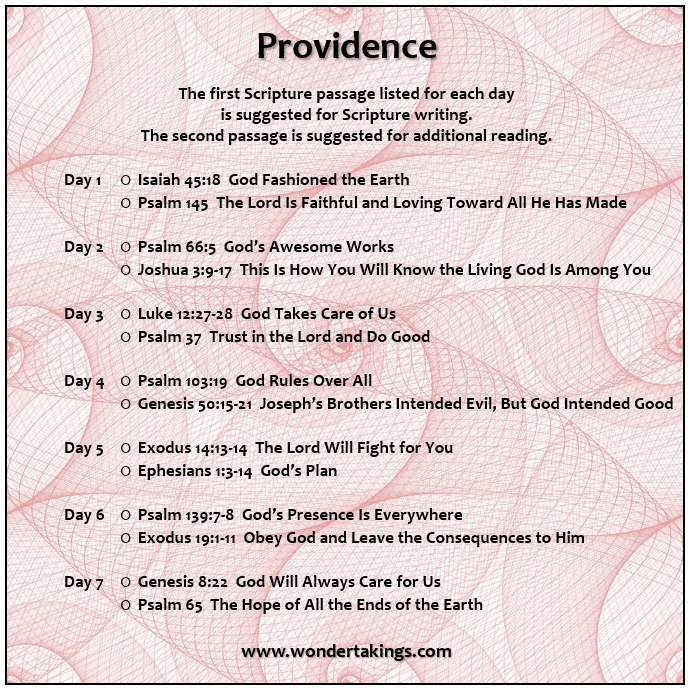Math, the Universe, and God’s Providence
“And we know that in all things God works for the good of those who love him, who have been called according to his purpose.”
Romans 8:28 NIV

This week I’ve chosen some really big topics, but don’t worry! I don’t plan to get too technical. I just want to focus on how these subjects are related, which is this: Our awesome Creator designed and sustains our amazing universe in order to bring about His “good, pleasing and perfect will” (Romans 12:2 NIV).
Math Is Everywhere
“Mathematics is the language with which God has written the universe.”
Galileo Galilei
Physicist Max Tegmark wrote a book titled Our Mathematical Universe in which he explores the nature of physical reality on very large and very small scales. He concludes that everything leads to mathematics. In fact, he believes that everything that exists in the universe (or, more specifically, in four levels of multiverses) is actually a mathematical structure. As we prepare to discuss God’s providence, let’s start with some of the ideas in Dr. Tegmark’s book.
Scientists and philosophers have been fascinated by the mathematical nature of our universe for centuries. Dr. Tegmark quotes physics Nobel laureate Eugene Wigner: “The enormous usefulness of mathematics in the natural sciences is something bordering on the mysterious and . . . there is no rational explanation for it.” Mathematics is evident throughout the natural world. Here are a few examples:



We can also find mathematics when we study how things move. When we throw an object up into the air with forward velocity, it always traces the same shape: an upside-down parabola. A parabola can be described by a simple mathematical equation.

Orbits of objects in space trace another recurring shape: an ellipse. An ellipse can also be described by a mathematical equation. And it turns out that parabolas and ellipses are related. A parabola is actually part of an ellipse. So the parabolic trajectory of an object thrown into the air on earth is really just a “piece” of an elliptical orbit.

Max Tegmark explains, “We humans have gradually discovered many additional recurring shapes and patterns in nature, involving not only motion and gravity, but also areas as disparate as electricity, magnetism, light, heat, chemistry, radioactivity and subatomic particles. These patterns are summarized by what we call our laws of physics. Just as the shape of an ellipse, all these laws can be described using mathematical equations.” Dr. Tegmark points out that there are also “fundamental numbers” which occur in nature as properties of our physical reality. For example, the dimensionality, curvature, and topology of space and the charge, spin, and lepton number of elementary particles are all numbers which describe the instrinsic properties of our physical world. Captivated by all these mathematical clues, Dr. Tegmark came to a conclusion: “I suddenly had an idea for what it all meant: that our reality isn’t just described by mathematics — it is mathematics, in a very specific sense, . . . Not just aspects of it, but all of it, including you.” He devised what he calls the Mathematical Universe Hypothesis, which states that “our external physical reality is a mathematical structure.”
I admit I don’t understand everything Dr. Tegmark discusses in his book, and I don’t know if he’s right, but it’s very intriguing. It would not surprise me at all if God, in creating the universe, revealed Himself to be not only a Master Artist but an Expert Scientist and Mathematician as well. To me, Dr. Tegmark’s discoveries reveal God’s extraordinary design in a new and exciting way! And the next time one of my math students asks me, “Why do we have to learn all this stuff?” I can answer, “because you are all this stuff!” So now let’s discuss how this helps us understand the universe.
“On the largest and smallest scales, the mathematical fabric of reality becomes evident, while it remains easy to miss on the intermediate scales that we humans are usually aware of.”
Max Tegmark, Our Mathematical Universe
What Is the Universe?

Belief in the existense of parallel universes is becoming more mainstream among physicists. So, more specifically, we should ask, “What is our universe?” Max Tegmark defines our universe as “The spherical region of space from which light has had time to reach us during the 14 billion years since our Big Bang.” He defines physical reality as “everything that exists” and our universe as “the part of physical reality we can in principle observe.” He also gives definitions of parallel universes and multiverses, but this is more information than we need for our purposes. So we will just stick to discussing our universe.
“The distinction between past, present, and future is only a stubbornly persistent illusion.”
Albert Einstein
Dr. Tegmark argues that since our physical reality is a mathematical structure, it exists outside space and time. He says, “if the history of our Universe were a chess game, the mathematical structure would correspond not to a single position, but to the entire game. If the history of our Universe were a movie, the mathematical structure would correspond not to a single frame but to the entire DVD.” C. S. Lewis makes a similar comparison, which we’ll discuss below.
What Do We Mean by God’s Providence?

“At the center of the Christian faith is the conviction that in the universe there is a God of power who is able to do exceedingly abundant things in nature and in history.”
Martin Luther King, Jr.
C. S. Lewis explains that since God is outside of time, “To Him all the physical events and all the human acts are present in an eternal Now. The liberation of finite wills and the creation of the whole material history of the universe (related to the acts of those wills in all the necessary complexity) is to Him a single operation. In this sense God did not create the universe long ago but creates it at this minute — at every minute.” Lewis uses the following analogy to explain how God’s providence is adapted to our free will. Suppose my life can be represented by a black wavy line, where each turn represents a decision I make. From my perspective, I live my life sequentially, creating new turns from moment to moment, unable to change past decisions and unaware of what my future decisions will be. But God sees every one of my decisions all at once. He sees the entire shape of my life:

God can, therefore, design the course of material events, represented by red lines in the drawing below, to accomplish His will while still being adapted to my free choices . . . even my bad ones. This, quite frankly, is a very comforting thought. Even when I mess up, God can still use my mess for good. As I move through my life, I find the red lines adjusted to my decisions and yet still arranged according to God’s will:

I might pray when I reach a certain point in my life to find the red lines arranged in a certain way. This prayer may or may not be granted. What I need to remember is my life is not the only one to which the red lines need to be adapted. God must adapt the course of all material events not only to my life, but to everyone else’s as well, and most importanly, to His own plan. If I could see everything from God’s point of view, I would see a much more complex and beautiful design than is possible to see from my limited human perspective. Let’s zoom out from the image above and see the big picture:

God’s design is more sophisticated and wonderful than we can imagine or even understand. And the most amazing thing about it is the fact that God allows us to be a part of His cosmic plan. He adapts His design to our free will. Theologian John Calvin (1509-1564) said, “the presence of the divine power is conspicuous, not less in the perpetual condition of the world than in its first creation.” God didn’t just set the universe in motion in a single moment a long time ago, but He constantly creates and maintains it, and He invites us to participate. The prayers we offer today may affect what happens in the future, or — and this really blows my mind — may be what affected the outcome of an event in the past!
“That’s why we can be so sure that every detail in our lives of love for God is worked into something good. God knew what he was doing from the very beginning. He decided from the outset to shape the lives of those who love him along the same lines as the life of his Son. The Son stands first in the line of humanity he restored. We see the original and intended shape of our lives there in him.”
Romans 8:28-29 MSG
Participating in God’s Work

“With God there are no accidents.
Max Lucado, Grace for the Moment
Every incident is intended to bring us closer to him.”
God has purposes for our world and for us, and He wants us to join Him in bringing them to pass. A couple of years ago, my husband and I participated in a study of church doctrine called Christian Believer. The section on providence in the study manual declares, “From a human point of view, the doctrine of providence means God cares. The divinity is not aloof, but involved. . . . the issue in providential activity is the fulfilling of the purposes of God in history. This issue sees history — both corporate and personal — as having a purpose, and that purpose is God’s.” One of God’s purposes for us is to make us more like Christ. He uses circumstances to help shape us into the image of His Son so that we can help fulfill His purposes in the world. Since we cannot see the big picture, we may not always understand God’s plan, but God calls us to step out in faith and do what He asks of us. We can be sure that His plan is good. This gives us reason for hope and thanksgiving, even in difficult circumstances.
“Divine providence is the process by which God ensures good relations with all creatures, in order that their natures might be fulfilled.”
Jacobus Arminius
Being chosen by God is not necessarily easy or comfortable. We often grow through trials, and this can be hard. But it’s worth it if our spiritual development equips us to be a blessing to others. The Reverend Doctor Charles F. Stanley says, “True obedience means doing what God says, when He says it, how He says it should be done, until what He says is accomplished — regardless of whether you understand the reasons for it or not.” Dr. Stanley reminds us that as we trust in God, our faith matures and we become better prepared to carry out His work in the world.
This reminds me a lot of teaching students how to solve a complicated mathematics problem. As the teacher and someone who has been doing similar types of problems for many years, I know the best way to obtain the solution. I ask the students to trust me and to do what I tell them to, even if they aren’t sure about it or don’t like my method. Some ignore what I tell them and continue to plug away using their own flawed or inefficient procedures. These students usually struggle and are unable to move on. Eventually, they may give up and declare how much they hate math and how pointless it all is. Those who trust me and take the time to learn what I teach them grow in mathematical maturity and are able to take on more challenging problems. Isn’t the same true of our faith? When I don’t trust God or follow His instructions, I may struggle for years, unable to move on in my spiritual journey. But when I trust God and take the time to learn what He is trying to teach me, I grow in spiritual maturity and am able to take on greater challenges.
How do we find out what God wants us to do? Ask Him, and then listen for His answer. For me this means being faithful in prayer and Bible study. Romans 12:2 has been a key verse in my life: “Do not conform any longer to the pattern of this world, but be transformed by the renewing of your mind. Then you will be able to test and approve what God’s will is — his good, pleasing and perfect will” (NIV). Dr. Stanley advises, “spend time in prayer asking God to draw you into intimate communion with Himself and to transform your life so that you can affect the world for the sake of His kingdom.” God is able to bring about His will in the universe and in us, and He invites us to help Him do it.
“The ringing testimony of the Christian faith is that God is able. . . . God is able to sustain the vast scope of the physical universe. . . . God is able to subdue all the powers of evil. . . . God is able to give us interior resources to confront the trials and difficulties of life.”
Martin Luther King, Jr.
This week’s Scripture passages focus on God’s providence in the world. There is a printer-friendly pdf version below the image. May they remind us that God has a plan for everything, including us, and His plan is always good!

“‘For I know the plans I have for you,’ declares the Lord, ‘plans to prosper you and not to harm you, plans to give you hope and a future.'”
Jeremiah 29:11 NIV
References:
- Christian Believer: Knowing God with Heart and Mind — Readings. Abingdon Press, 1999.
- Kalas, J. Ellsworth. Christian Believer: Knowing God with Heart and Mind — Study Manual. Abingdon Press, 1999.
- Lewis, C. S. How to Pray: Reflections & Essays. Harper One, 2018.
- Lucado, Max. Grace for the Moment: Inspirational Thoughts for Each Day of the Year. J. Countryman, 2000.
- Stanley, Charles F. 30 Life Principles Study Guide: A Study for Growing in Knowledge and Understanding of God. Thomas Nelson, 2008.
- Tegmark, Max. Our Mathematical Universe: My Quest for the Ultimate Nature of Reality. Vintage Books, A Division of Random House LLC, 2014.
Images:
- Featured image by Karen Smits from Pixabay
- World image by Gerd Altmann from Pixabay
- Nautilus Shell image by Peggy und Marco Lachmann-Anke from Pixabay
- Honeycomb image by Britta Gade from Pixabay
- Romanesco image by Albrecht Fietz from Pixabay
- Rocket Launch image by SpaceX-Imagery from Pixabay
- Ellipses image by Gerd Altmann from Pixabay
- Universe image by Gerd Altmann from Pixabay
- Night Sky image by Pexels from Pixabay
- Red Lines Abstract image by David Zydd from Pixabay
- Winding Road image by David Mark from Pixabay
Comment Christa, i am so impressed with your Wondertskings. This one has me thinking about God and the universe in a whole new direction.